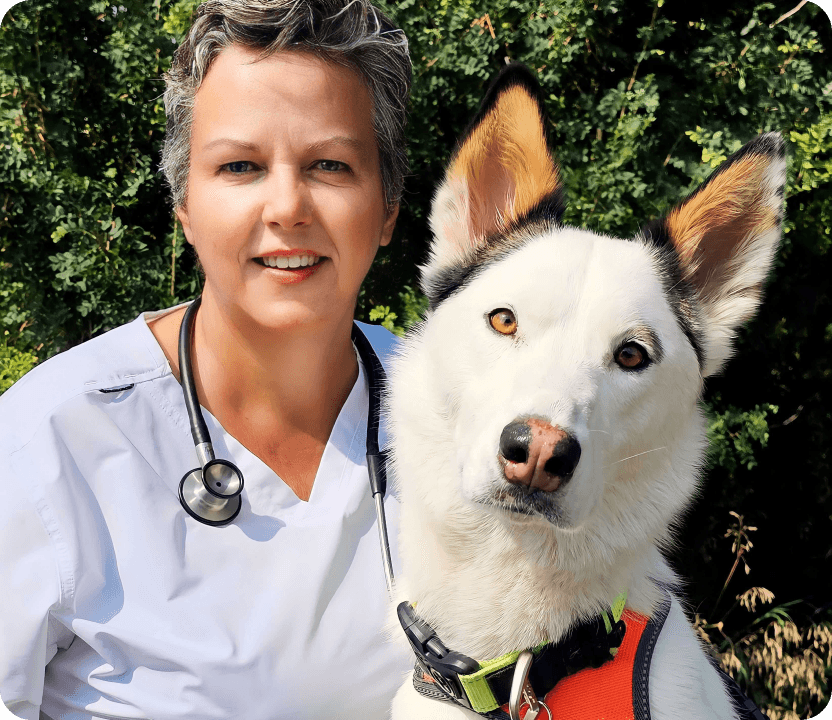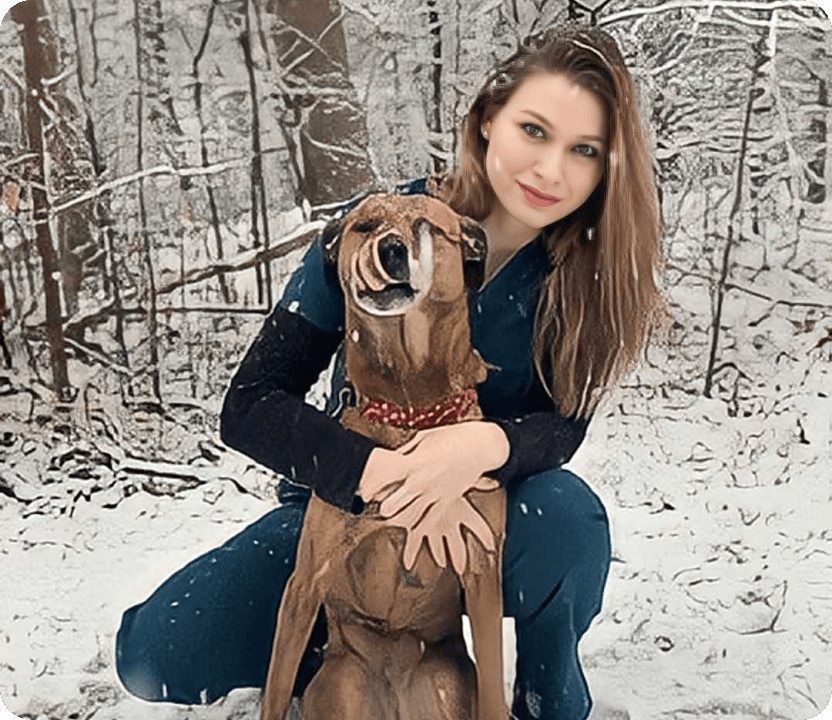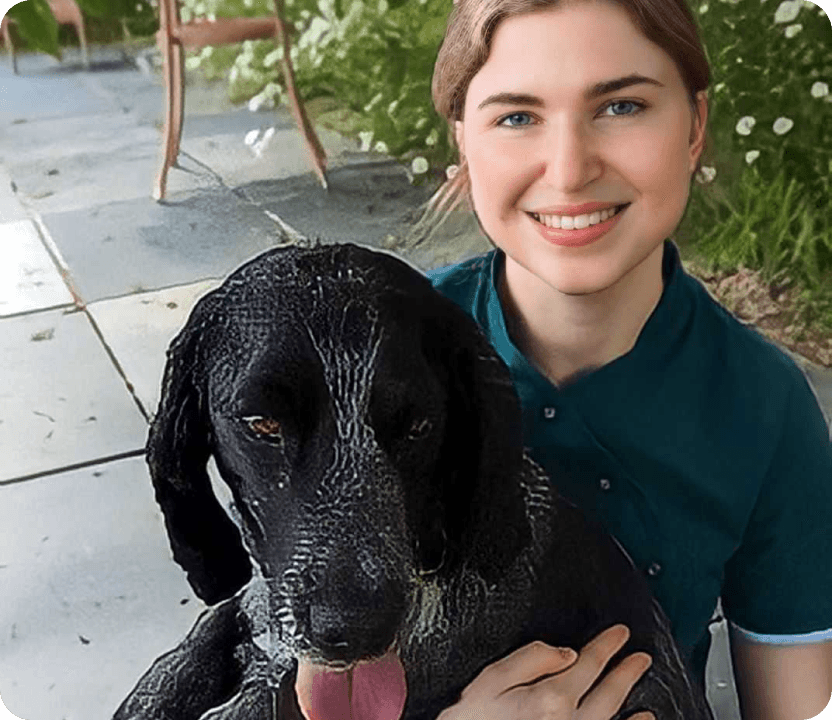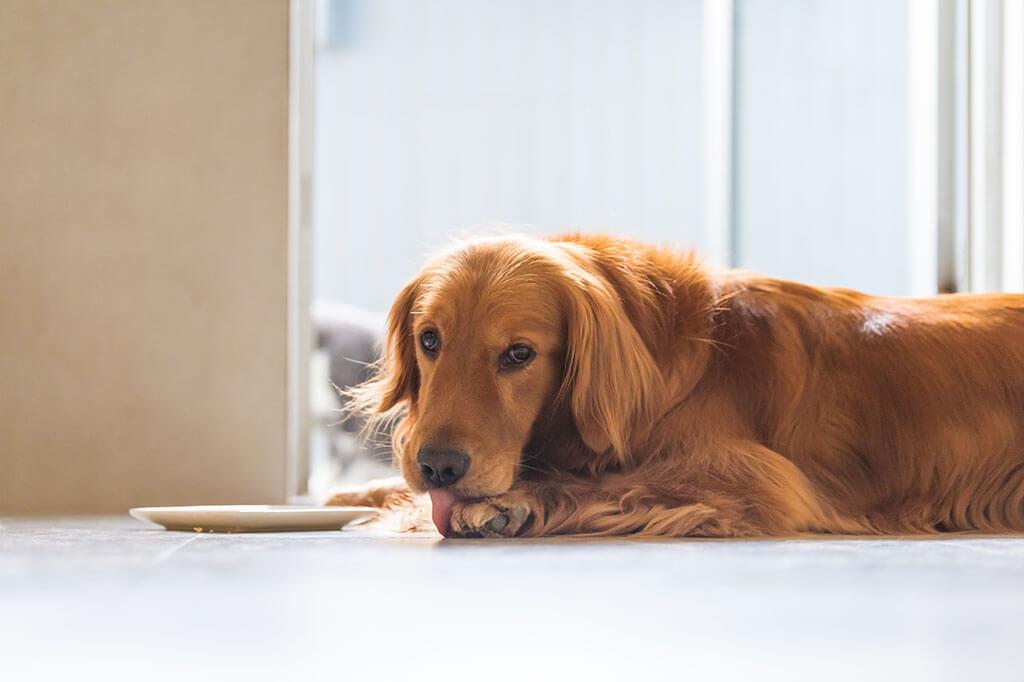Understanding the cause of this behavior can help you find the right solution to put an end to it once and for all. In this article, we will explore the different causes of excessive paw licking in dogs as well as potential treatment options and preventive measures that pet owners should consider.
Key facts
- The most common reason for excessive paw licking in dogs is itchiness caused by allergies.
- Other causes include bacterial or fungal infection, injuries, pain, as well as behavioral issues such as boredom, anxiety, or stress.
- Paw licking can lead to more serious skin issues such as infections, acral lick granulomas, and cracked paw pads.
- Treatment options for excessive paw licking depend on the underlying cause and often require veterinary intervention.
- Medications and supplements can greatly reduce allergy symptoms, including paw licking.
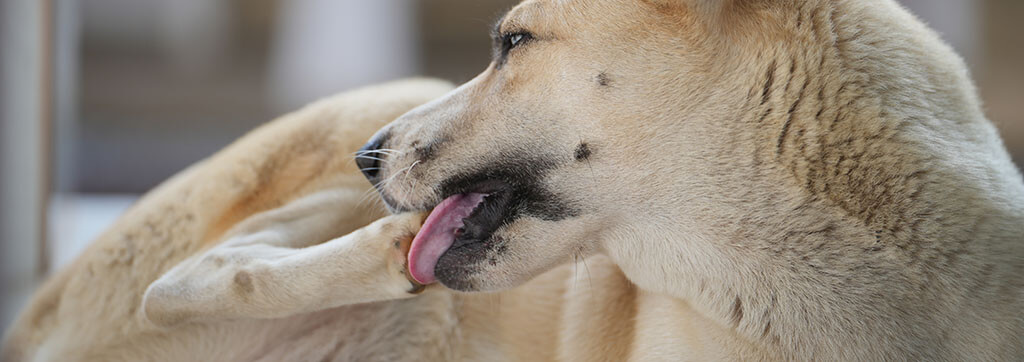
Why do dogs lick their paws?
All dogs occasionally lick their paws. In most cases, this is perfectly normal grooming behavior. Dogs lick their paws to clean them and to remove minor and temporary irritants such as burrs stuck to their fur or dirt between their toes.
However, frequent or constant paw licking is not normal. A dog licking its paws all the time might have a hidden health problem that, if not addressed, could turn into a bigger problem.
Paw licking is not only a concern because of the underlying reasons behind it, but also because excessive licking can lead to more serious skin issues including:
- Secondary infections: Moisture and irritation from licking can create an ideal environment for bacteria or fungi to grow. This results in painful skin infections.
- Open sores: Constant licking at one area of the leg can result in painful, open sores known as acral lick granulomas, which are difficult to treat.
- Cracked paw pads: Repetitive licking can damage the skin of the paw pads, removing natural oils and leading to dry, cracked, and painful pads.
- Compulsive licking: Constant licking can become a persistent habit that is difficult to break even when the initial cause is gone.
The key to stopping this behavior is to understand why your dog is licking its paws in the first place. Once the underlying cause is determined, it can be addressed and treated.
Reasons why a dog keeps licking its paw
Allergies
Allergies are the most common cause of paw licking in dogs. Dogs have allergic reactions to certain substances, known as allergens.
These allergens can be found in the environment, food, or parasites, and can trigger inflammation, leading to excessive paw licking. Allergens that commonly affect dogs include pollen, dust mites, certain foods, and fleas.
When a dog comes into contact with these allergens, its immune system responds by releasing histamines and other inflammatory molecules, which cause inflammation and itchiness. This often occurs on the feet and toes, causing the dog to keep licking its paws to try to relieve the discomfort.
Dogs with allergies may obsessively lick their paws, often to the point of causing trauma. This results in more pain in the paw and leads to even more licking.
Infections
Infections of the skin are usually painful and itchy. Licking is a natural response for dogs to try to soothe the pain and get rid of the discomfort and irritation.
There are four main causes of skin infections in dogs: bacterial, yeast, fungal, and mites. Each type of infection is unique and requires specific treatment approaches:
- Bacterial infections occur when bacteria such as Staphylococcus or Streptococcus enter damaged skin. The infected skin becomes red and inflamed with swelling, pain, and discharge.
- Yeast, specifically the Malassezia species, can overgrow in the warm and moist environment between the toes. Dogs with yeast infections may show symptoms such as itching, redness, greasy or waxy discharge, and an unpleasant odor.
- Fungal infections, specifically ringworm, are highly contagious fungal infections that can affect not only the skin but also the nails of dogs. Ringworm causes redness, circular lesions, hair loss, and intense itching.
- Mites, such as Sarcoptes scabiei and Demodex, cause itching, irritation, redness, hair loss, and crusting of the paws.
Injuries and pain
Dogs may begin paw licking as a result of various injuries or pain sources. These can include:
- Cuts and abrasions: Open wounds on the paw can cause pain and discomfort.
- Burns: Dogs can sustain burns on their paws from hot surfaces, chemicals, or fire, which can cause pain.
- Punctures: Sharp objects, such as nails or thorns, can penetrate a dog’s paw, causing pain and potentially leading to infection.
- Foreign bodies: Splinters or glass that get embedded in the paw can cause pain and irritation.
- Broken or overgrown nails: When a dog’s nails are damaged or too long, they can press against the paw pads, which causes pain.
- Environmental irritants: Chemicals like road salt, ice melt, cleaning products, pesticides, or certain plants, can irritate a dog’s paw pads.
- Arthritis: This degenerative joint disease can cause inflammation, swelling, and pain in the joints, including the paws.
While a dog’s instinct to clean a wound is natural, excessive licking can hinder the healing process and increase the risk of infection. It’s important to address the underlying cause of the pain or injury and provide appropriate treatment to alleviate the dog’s discomfort.

Behavioral problems
Besides physical reasons such as pain or injury, dogs may also excessively lick their paws due to underlying behavioral issues. These can be more difficult to figure out since they are rooted in the dog’s emotions and mental state, and dogs are unable to tell us what they are “feeling”.
Behavioral causes can include boredom, anxiety/stress, habit, or an underlying obsessive-compulsive disorder (in dogs, this is known as Canine Compulsive Disorder). Dogs that are suffering from these conditions may keep licking their paws to achieve the following:
- Self-soothing: Dogs may find comfort or relief from emotional distress by paw licking, similar to how humans may engage in certain behaviors (e.g. nail-biting or hair-twirling) when feeling anxious.
- Stimulation and distraction: The repetitive motion and physical sensation of licking may temporarily divert their attention away from their emotional discomfort.
- Release of endorphins: Licking can trigger the release of endorphins, which can provide a momentary sense of pleasure or relief. This “positive feedback” also reinforces the behavior, leading to its repetition.
Over time, excessive paw licking can become a habit even if the original trigger or underlying cause is no longer present.
How to stop a dog from licking its paws?
There are some things that can be done to get to the root cause of this behavior and provide relief for your canine companion:
- Observe your dog’s behavior: Assess if your dog is licking one or multiple paws. Allergies may cause a dog to lick multiple feet.
- Examination: If your dog will safely allow, see if there are any obvious signs of irritation or infection, such as redness, swelling, heat, peeling, or discharge.
- Seek veterinary assistance: If your dog’s signs are not improving or if there is an underlying medical problem, seek veterinary care.
- Use the appropriate treatment: Your veterinarian will recommend the best treatment option for your dog depending on the underlying cause of the problem. This may include treatment with anti-inflammatories, pain medication, topical treatments, etc.
- Paw Cleansing: Wipe or rinse the paws after a walk to remove environmental irritants or debris.
- Foot Protection: Use booties during the winter months to avoid contact with ice melt which can be damaging to the paw pads.
- Nail maintenance: Keep the paws clean and dry, trim nails appropriately, and regularly inspect for any signs of irritation or injury.
- Prevention of Licking: A bitter-tasting spray specifically made for applying to the paws can be used to deter habitual licking. Use an Elizabethan collar (cone) so that the dog cannot reach their paw to lick it.
- Adjust the Diet: Proteins such as poultry and beef are some of the most common food allergens. Switching the dog’s food to a hypoallergenic diet may improve the problem.
- Supplements: Dietary supplements with prebiotics such as inulin and probiotics such as Lactobacillus bacteria have been proven to reduce the symptoms of allergies.
Final words on dogs licking their paws
Paw licking can be caused by a variety of underlying issues and it’s important to identify the cause before you take any action. Veterinary assistance may be needed to help determine exactly why your dog is licking its paws all the time.
Once the source of the problem has been identified, then appropriate steps can be taken to treat it. In addition to treating the underlying issue, it is important to establish a routine for paw care to help prevent future problems with paw licking in your dog.
Explore PetLab Co.’s dog health collection, now. Where to start? Begin your pet’s health care journey with the best-selling Probiotic Chews in America*, alongside our full range of dental care items, and supplements for seasonal allergies.
Sources:
https://www.ncbi.nlm.nih.gov/pmc/articles/PMC4982575/pdf/cvj_09_991.pdf
https://www.msdvetmanual.com/integumentary-system/atopic-dermatitis/canine-atopic-dermatitis
https://doi.org/10.24425/pjvs.2023.145014
https://doi.org/10.1016/j.rvsc.2022.09.032
https://www.dvm360.com/view/acral-lick-granuloma-stopping-itch-lick-cycle
